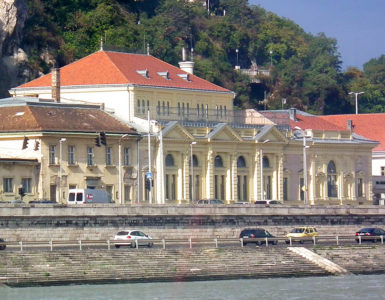
Sand Dunes Arch is an easy walk, as walks through the desert go — just a third of a mile, one-way. The going gets tougher when the trail veers up into a narrow shaft between two sheer rock walls; once there, the hard-scrabble desert floor gives way to fine, soft red sand that sucks at your shoes with every step.
The initial passageway is claustrophobic — less than a meter wide, with the vertical walls rising up more than 150 feet on either side. But soon enough, this entry slot widens, depositing visitors into what is, essentially, the bottom of a massive chimney of stone. The sky overhead is a remote oval of pure blue at the far end of a red-orange cylinder. The soft, sandy floor is the same color, making it difficult to tell, at a glance, just how huge the room really is.
Wading through the sand, we made our way around a tight corner into an adjoining chamber. There, the Sand Dune Arch sits in a cool, shady alcove of twisted flowstone, lit from above by a cone of indirect light. Here, too, the light and color of the room play tricks on the eye; when I hiked up the slope to stand beneath the arch and turned back to look at Clyde, I was startled to see how small and distant he appeared to be.
We were alone there, that morning — the only two people, as far as we knew, for miles. The sheltered space felt more like a room or a temple than a natural formation: something old, something ancient, something silent — but alive.
That afternoon, we returned with our friend Jackie, eager to share the peace of the place with her. Despite the harsh afternoon sunlight, the interior of the stone structure remained shady and cool, thanks to the tall, tapering walls.
But you can imagine our surprise when, upon rounding the corner to visit the arch, we stumbled on twenty-five young men, naked except for their gym shorts, playing a loud and rowdy game of tackle football. They dashed through the sand, their bare feet kicking up dusty gouts of color, throwing the ball, intercepting it, evading opponents, scoring. They were just a band of Mormon boys — Boy Scouts from Salt Lake, we found out later — but with their hair and bodies caked with sand, they looked like a bizarre band of natives who had somehow based their society on a discarded Abercrombie & Fitch catalog.
Up ahead, in what had been the silent room of the arch, two adult Scout leaders rested in the shade, while two other boys — smaller, skinner — amused themselves by setting a trap for tourists. The first boy would lie down in a shallow pit; the second would cover his friend completely with sand, hiding everything but his nostrils. When the work was done, the first boy was invisible (except for an almost imperceptible rising and falling of the dune as he breathed).
When hikers entered the room — already flustered and distracted by the football game — the first boy would burst up from the sand, his long arms clawing and his long legs kicking. Grown men jumped back; the boys roared. Then, the trap sprung, back to business. How quickly could Boy Number One be buried again? Was there a way his nose could be covered? Was there a way he could be buried face-down?
Same spot, completely different energy, and — both times — pure desert magic.



Add comment